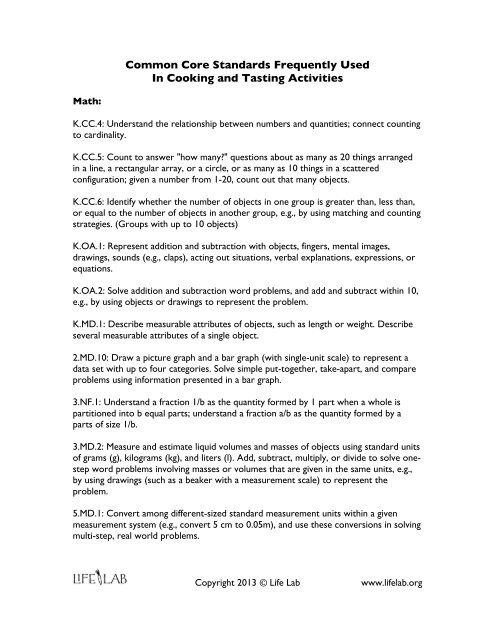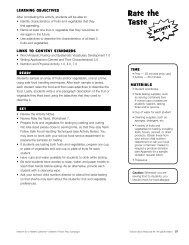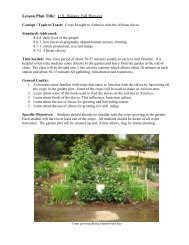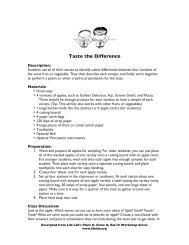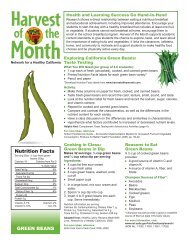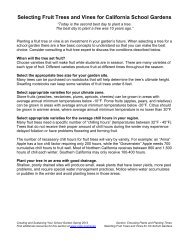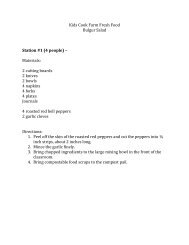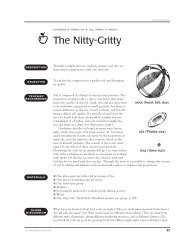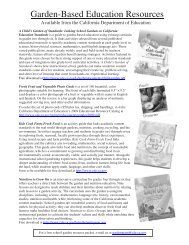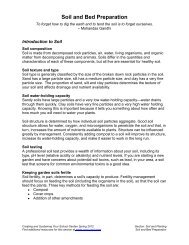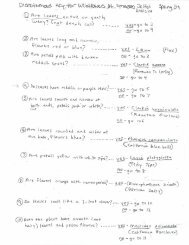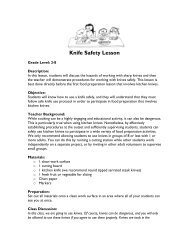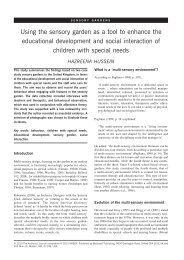Common Core Standards Frequently Used In Cooking ... - Life Lab
Common Core Standards Frequently Used In Cooking ... - Life Lab
Common Core Standards Frequently Used In Cooking ... - Life Lab
Create successful ePaper yourself
Turn your PDF publications into a flip-book with our unique Google optimized e-Paper software.
<strong>Common</strong> <strong>Core</strong> <strong>Standards</strong> <strong>Frequently</strong> <strong>Used</strong><br />
<strong>In</strong> <strong>Cooking</strong> and Tasting Activities<br />
Math:<br />
K.CC.4: Understand the relationship between numbers and quantities; connect counting<br />
to cardinality.<br />
K.CC.5: Count to answer "how many?" questions about as many as 20 things arranged<br />
in a line, a rectangular array, or a circle, or as many as 10 things in a scattered<br />
configuration; given a number from 1-20, count out that many objects.<br />
K.CC.6: Identify whether the number of objects in one group is greater than, less than,<br />
or equal to the number of objects in another group, e.g., by using matching and counting<br />
strategies. (Groups with up to 10 objects)<br />
K.OA.1: Represent addition and subtraction with objects, fingers, mental images,<br />
drawings, sounds (e.g., claps), acting out situations, verbal explanations, expressions, or<br />
equations.<br />
K.OA.2: Solve addition and subtraction word problems, and add and subtract within 10,<br />
e.g., by using objects or drawings to represent the problem.<br />
K.MD.1: Describe measurable attributes of objects, such as length or weight. Describe<br />
several measurable attributes of a single object.<br />
2.MD.10: Draw a picture graph and a bar graph (with single-unit scale) to represent a<br />
data set with up to four categories. Solve simple put-together, take-apart, and compare<br />
problems using information presented in a bar graph.<br />
3.NF.1: Understand a fraction 1/b as the quantity formed by 1 part when a whole is<br />
partitioned into b equal parts; understand a fraction a/b as the quantity formed by a<br />
parts of size 1/b.<br />
3.MD.2: Measure and estimate liquid volumes and masses of objects using standard units<br />
of grams (g), kilograms (kg), and liters (l). Add, subtract, multiply, or divide to solve onestep<br />
word problems involving masses or volumes that are given in the same units, e.g.,<br />
by using drawings (such as a beaker with a measurement scale) to represent the<br />
problem.<br />
5.MD.1: Convert among different-sized standard measurement units within a given<br />
measurement system (e.g., convert 5 cm to 0.05m), and use these conversions in solving<br />
multi-step, real world problems.<br />
Copyright 2013 © <strong>Life</strong> <strong>Lab</strong> www.lifelab.org
Language Arts<br />
K.RL.5 Actively engage in group reading activities with purpose and understanding.<br />
K.W.3 Use a combination of drawing, dictating, and writing to narrate a single event or<br />
several loosely linked events, tell about the events in the order in which they occurred,<br />
and provide a reaction to what happened.<br />
K.L.5.a Sort common objects into categories (e.g., shapes, foods) to gain a sense of the<br />
concepts the categories represent.<br />
K.L.5.c Identify real-life connections between words and their use (e.g., note places at<br />
school that are colorful).<br />
1.RF.4.a Read on-level text with purpose and understanding.<br />
1.L.5.c Identify real-life connections between words and their use (e.g., note places at<br />
home that are cozy).<br />
1.W.3 Write narratives in which they recount two or more appropriately sequenced<br />
events, include some details regarding what happened, use temporal words to signal<br />
event order, and provide some sense of closure.<br />
2.L.5.d Distinguish shades of meaning among verbs differing in manner (e.g., look, peek,<br />
glance, stare, glare, scowl) and adjectives differing in intensity (e.g., large, gigantic) by<br />
defining or choosing them or by acting out the meanings.<br />
2.RI.5 Know and use various text features (e.g., captions, bold print, subheadings,<br />
glossaries, indexes, electronic menus, icons) to locate key facts or information in a text<br />
efficiently.<br />
2.RI.10 By the end of year, read and comprehend informational texts, including<br />
history/social studies, science, and technical texts, in the grades 2–3 text complexity<br />
band proficiently, with scaffolding as needed at the high end of the range.<br />
2.SL.1 Participate in collaborative conversations with diverse partners about grade 2<br />
topics and texts with peers and adults in small and larger groups.<br />
2.L.5.a Identify real-life connections between words and their use (e.g., describe foods<br />
that are spicy or juicy).<br />
2.L.5.b Distinguish shades of meaning among closely related verbs (e.g., toss, throw,<br />
hurl) and closely related adjectives (e.g., thin, slender, skinny, scrawny).<br />
3.RF.4.a Read on-level text with purpose and understanding.<br />
Copyright 2013 © <strong>Life</strong> <strong>Lab</strong> www.lifelab.org
3.RI.10 By the end of the year, read and comprehend informational texts, including<br />
history/social studies, science, and technical texts, at the high end of the grades 2–3 text<br />
complexity band independently and proficiently.<br />
3.SL.4 Report on a topic or text, tell a story, or recount an experience with<br />
appropriate facts and relevant, descriptive details, speaking clearly at an understandable<br />
pace.<br />
4.RF.4.a Read on-level text with purpose and understanding.<br />
4.SL.1 Engage effectively in a range of collaborative discussions (one-on-one, in groups,<br />
and teacher- led) with diverse partners on grade 4 topics and texts, building on others’<br />
ideas and expressing their own clearly.<br />
4.RI.10 By the end of year, read and comprehend informational texts, including<br />
history/social studies, science, and technical texts, in the grades 4–5 text complexity<br />
band proficiently, with scaffolding as needed at the high end of the range.<br />
5.SL.1 Engage effectively in a range of collaborative discussions (one-on-one, in groups,<br />
and teacher- led) with diverse partners on grade 5 topics and texts, building on others’<br />
ideas and expressing their own clearly.<br />
5.RI.10 By the end of the year, read and comprehend informational texts, including<br />
history/social studies, science, and technical texts, at the high end of the grades 4–5 text<br />
complexity band independently and proficiently.<br />
Copyright 2013 © <strong>Life</strong> <strong>Lab</strong> www.lifelab.org


